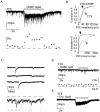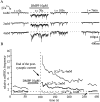Role of Ca2+ ions in nicotinic facilitation of GABA release in mouse thalamus
- PMID: 8987780
- PMCID: PMC6573224
- DOI: 10.1523/JNEUROSCI.17-02-00576.1997
Role of Ca2+ ions in nicotinic facilitation of GABA release in mouse thalamus
Abstract
Presynaptic nicotinic acetylcholine receptors (nAChRs) are present in many regions of the brain and potentially serve as targets for the pharmacological action of nicotine in vivo. To investigate their mechanism of action, we performed patch-clamp recordings in relay neurons from slices of thalamus sensory nuclei. In these nuclei, nAChR activation facilitated the release of the inhibitory neurotransmitter GABA. Micromolar concentrations of nicotinic agonists increased the frequency of miniature GABAergic synaptic currents and decreased the failure rate of evoked synaptic currents. These actions of nicotinic agonists were not observed in knock-out mice lacking the beta 2 nAChR subunit gene. Nicotinic effects were dependent on extracellular calcium ions, and they persisted when calcium was replaced by strontium or barium but not by magnesium. Furthermore, in high extracellular calcium concentrations, nicotinic agonists evoked an increase in spontaneous release lasting for minutes after removal of the agonist. This supports the view that presynaptic nAChRs facilitate the release of neurotransmitter by increasing the calcium concentrations in presynaptic nerve endings. With use of cadmium and nickel ions as selective blockers, it was found that in different sensory nuclei the presynaptic influx of calcium could result either from the activation of voltage-dependent calcium channels or from a direct influx through nAChR channels. Finally, we propose that the nicotinic facilitation of GABAergic transmission may contribute to the increase of signal-to-noise ratio observed in the thalamus in vivo during arousal.
Figures









Similar articles
-
Nicotine facilitates glycine release in the rat spinal dorsal horn.J Physiol. 2001 Oct 1;536(Pt 1):101-10. doi: 10.1111/j.1469-7793.2001.t01-1-00101.x. J Physiol. 2001. PMID: 11579160 Free PMC article.
-
Nicotinic receptors regulate the release of glycine onto lamina X neurones of the rat spinal cord.Neuropharmacology. 2002 Nov;43(6):1044-54. doi: 10.1016/s0028-3908(02)00121-1. Neuropharmacology. 2002. PMID: 12423674
-
Calcium mobilization elicited by two types of nicotinic acetylcholine receptors in mouse substantia nigra pars compacta.Eur J Neurosci. 2000 Jul;12(7):2475-85. doi: 10.1046/j.1460-9568.2000.00138.x. Eur J Neurosci. 2000. PMID: 10947823
-
Modulatory role of presynaptic nicotinic receptors in synaptic and non-synaptic chemical communication in the central nervous system.Brain Res Brain Res Rev. 1999 Nov;30(3):219-35. doi: 10.1016/s0165-0173(99)00016-8. Brain Res Brain Res Rev. 1999. PMID: 10567725 Review.
-
Recent progress in the development of subtype selective nicotinic acetylcholine receptor ligands.Curr Drug Targets CNS Neurol Disord. 2002 Aug;1(4):337-48. doi: 10.2174/1568007023339256. Curr Drug Targets CNS Neurol Disord. 2002. PMID: 12769608 Review.
Cited by
-
Neuroimaging insights into the role of cortical GABA systems and the influence of nicotine on the recovery from alcohol dependence.Neuropharmacology. 2011 Jun;60(7-8):1318-25. doi: 10.1016/j.neuropharm.2011.01.020. Epub 2011 Jan 27. Neuropharmacology. 2011. PMID: 21276806 Free PMC article. Review.
-
Presynaptic α4β2 nicotinic acetylcholine receptors increase glutamate release and serotonin neuron excitability in the dorsal raphe nucleus.J Neurosci. 2012 Oct 24;32(43):15148-57. doi: 10.1523/JNEUROSCI.0941-12.2012. J Neurosci. 2012. PMID: 23100436 Free PMC article.
-
Diversity and distribution of nicotinic acetylcholine receptors in the locus ceruleus neurons.Proc Natl Acad Sci U S A. 1999 Oct 12;96(21):12126-31. doi: 10.1073/pnas.96.21.12126. Proc Natl Acad Sci U S A. 1999. PMID: 10518587 Free PMC article.
-
Conditional expression in corticothalamic efferents reveals a developmental role for nicotinic acetylcholine receptors in modulation of passive avoidance behavior.J Neurosci. 2003 May 1;23(9):3837-43. doi: 10.1523/JNEUROSCI.23-09-03837.2003. J Neurosci. 2003. PMID: 12736354 Free PMC article.
-
beta 2 nicotinic acetylcholine receptor subunit modulates protective responses to stress: A receptor basis for sleep-disordered breathing after nicotine exposure.Proc Natl Acad Sci U S A. 2002 Oct 1;99(20):13272-7. doi: 10.1073/pnas.192463599. Epub 2002 Sep 12. Proc Natl Acad Sci U S A. 2002. PMID: 12228730 Free PMC article.
References
-
- Alkondon M, Albuquerque EX. Diversity of nicotinic acetylcholine receptors in rat hippocampal neurons. I. Pharmacological and functional evidence for distinct structural subtypes. J Pharmacol Exp Ther. 1993;265:1455–1473. - PubMed
-
- Ankri N, Legendre P, Faber DS, Korn H. Automatic detection of spontaneous synaptic responses in central neurons. J Neurosci Methods. 1994;52:87–100. - PubMed
-
- Britto L, Keyser K, Lindstrom J, Karten H. Immunohistochemical localization of nicotinic acetylcholine receptor subunits in the mesencephalon and diencephalon of the chick (Gallus gallus). J Comp Neurol. 1992;317:325–340. - PubMed
-
- Clarke PBS, Pert A. Autoradiographic evidence for nicotine receptors on nigrostriatal and mesolimbic dopaminergic neurons. Brain Res. 1985;348:355–358. - PubMed
Publication types
MeSH terms
Substances
LinkOut - more resources
Full Text Sources
Other Literature Sources
Miscellaneous
